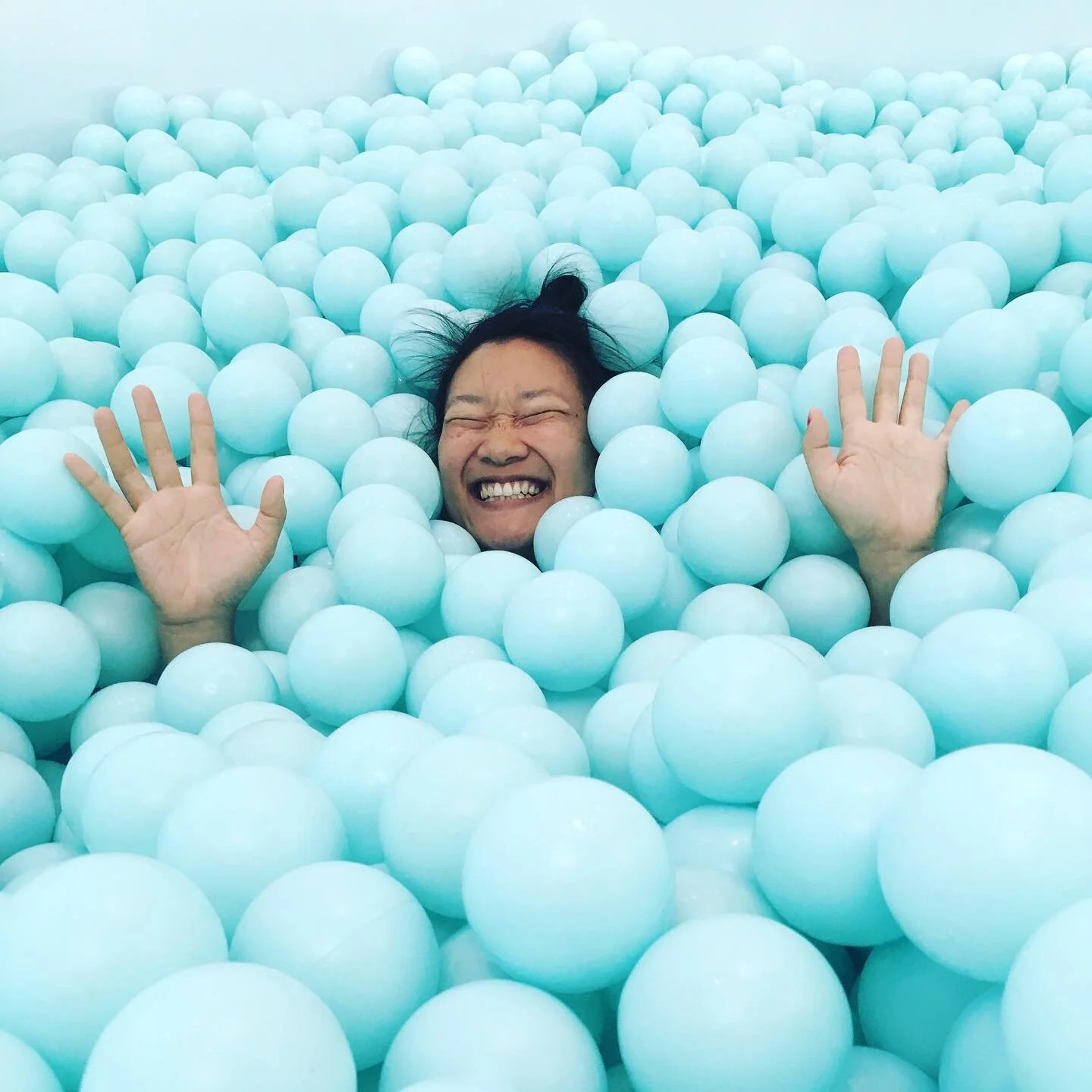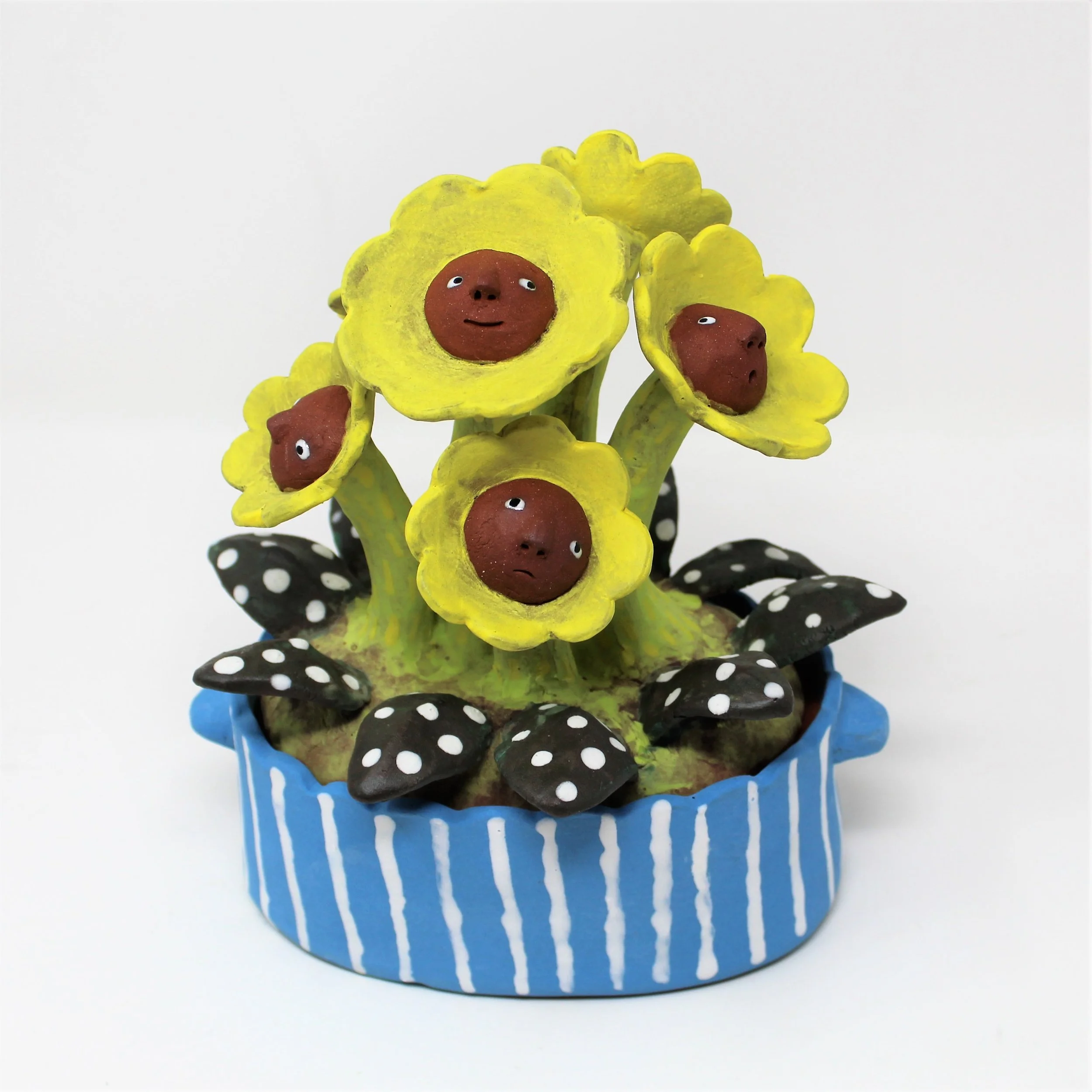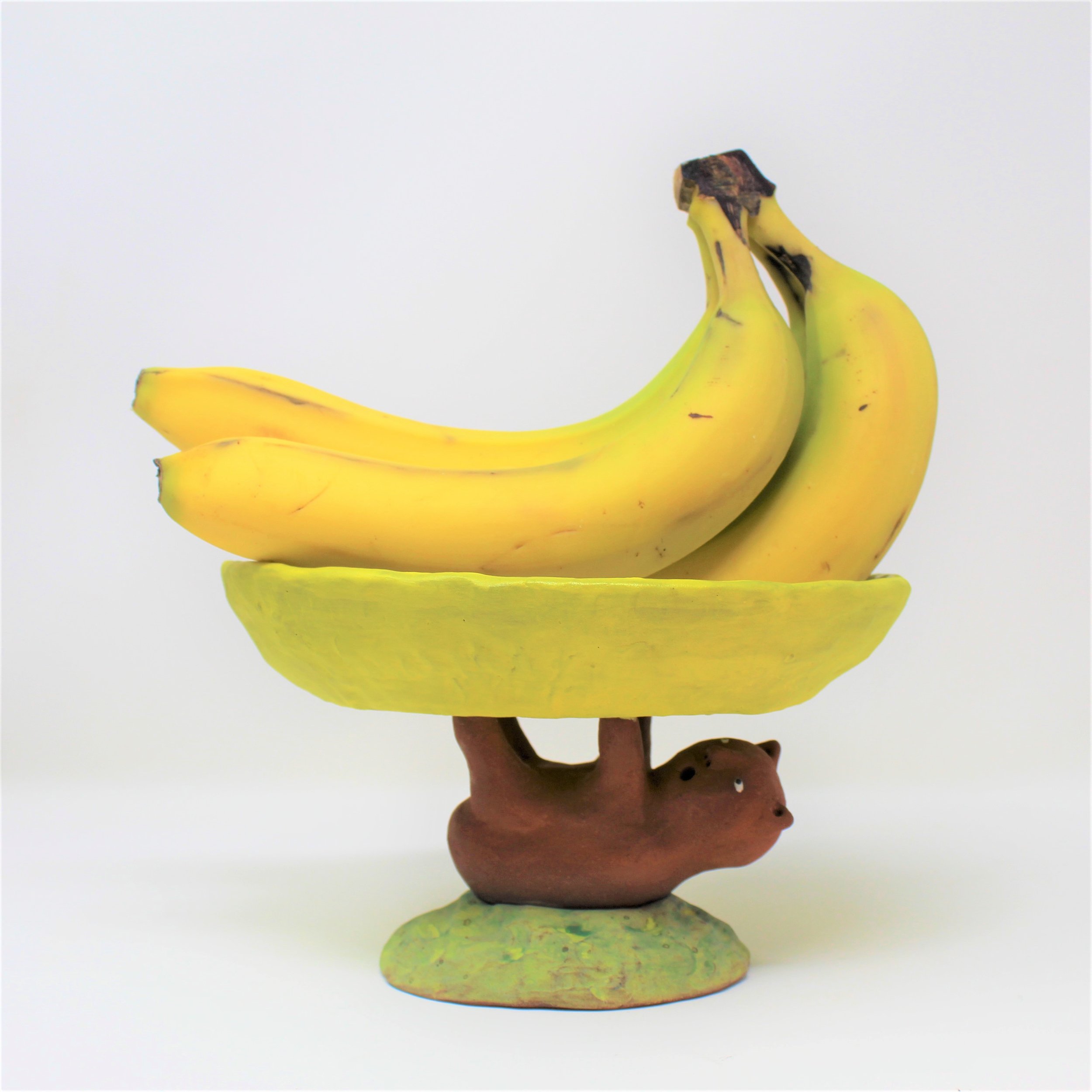Nikki Lau at The Color Factory NYC. Photo by Sandy Lam.
Spotlight Artist: Nikki Lau
BIO
Nikki Lau was born and raised in San Francisco, CA. She was a 2010-2011 Alumni of AmeriCorps/Public Allies, resulting in her work shifting to themes of social justice and identity politics. She received her MFA with a concentration in ceramics at Pennsylvania State University in State College, PA in 2016. Penn State awarded her the Bunton Waller Assistantship. She received her BA in Interdisciplinary Visual Arts at the University of Washington in Seattle, WA in 2008. She was the artist resident at The Clay Art Center in Port Chester, New York from 2018-2019 and the 2019-2020 resident at Armory Art Center in West Palm Beach, Florida. She currently splits her time between California and Pennsylvania living her snowbird life as she works on her pottery and home décor business Little Lau Shop.
Flower Jar, 2021. Red clay, glaze and underglaze. 7 x 6 x 8 inches.
ARTIST STATEMENT
I started Little Lau Shop to care for and love my inner child.
I have what you would call resting happy face, because of this I make creatures with different and unique facial expressions that have big and small emotions.
Through pottery, sculpture, and home décor, I create friends that help navigate the loneliness of the pandemic.
One of my heroes growing up and still feels important today is Mr. Rogers.
I make worlds where everything is a little bit kinder, gentler, more patient and empathic.
To find out more about Nikki Lau check out her Instagram, website, and of course, Little Lau Shop.
Interview with Nikki Lau
Bread Plate, 2021. Porcelain like clay, glaze and underglaze. 6.5 x 7.5 x 1 inches.
Hi Nikki. What’s your background and how did you get started in ceramics?
I have over 14 years of ceramic experience and was mostly doing sculptures for the majority of it. I started taking sculpture and ceramic classes in undergrad and continued with classes in community college after I graduated. I did a year at AmeriCorps and fell in love with social justice and activism. I started to find my voice in identity politics soon after. I applied to grad school, and it took me to Penn State where I got my MFA in ceramics. I bounced around the east coast from work exchange programs at the Clay Studio Philadelphia to residencies at The Clay Art Center in New York and The Armory Art Center in Florida. It was at the Armory that I tried more design and pottery.
I created my business Little Lau Shop at the height of the pandemic as my residency in Florida shut down. I was feeling lonely during quarantine, and I could feel my inner child freaking out from all the uncertainty in the world. I wanted to create a world where she felt nurtured and safe, and where you embrace all your feelings. My current style formed by combining my sculptures with pottery to create anthropomorphic objects that play well into the world of magical realism. My pots are like friends: human, imperfect and there to keep you company as you drink your coffee in the morning or have a snack. They are a gentle reminder that you are not alone.
Small Flower Jar, 2020. Red clay, glaze and underglaze. 3.5 x 4.25 x 6 inches.
Where are you currently based? Is your work informed by your surroundings?
I am currently a snowbird. I split my time 50-50 between the west coast and east coast. I absolutely hate snow, I’m a California girl all the way, but I love the east coast. In the fall and winter, I head home to California and am a part of a community studio called Clay by the Bay in San Francisco. In the spring and summer, I am in rural central Pennsylvania at my home studio that I set up in my friend Jamie Heilman’s stone house from the 1800’s. Basically I’m a city and country gal. When I’m in the country, my pottery gets a lot of inspiration from the plants, animals, and home cooking. When I’m in the city, I’m inspired by the energy, sights, art, people, and aesthetics. Country life is domestic ritual and city life is free form jazz.
How have you adjusted your studio set-up to suit Little Lau Shop?
I’m still figuring it all out. I have two studios technically, but a few commonalities. The documentation, packing and shipping set up is the same. With my rural home studio, I can roll out of bed, make coffee, do a load of laundry all while spreading out all over several tables as I wait for my clay to set. But that routine can get stale. With the city studio, it’s a constant negotiation for space and storage. My business relies on production so making a decent amount of product is crucial. So far, it’s working, you just get really inovative with storage. The people and the creative energy from city living makes it worth it. I work well under limitations; it’s how I was able to start a whole business during the pandemic.
Egg Plate, 2021. Porcelain like clay, glaze and underglaze. 9.5 x 9.25 x .5 inches.
Humor plays a big role in your ceramic practice. What’s your relationship to humor and what function does it play in art and life?
There’s an element of magical realism in my work. I make a lot of pottery with faces and big personalities. I constantly joke that I seem to capture a lot of anxiety in the eyes. My pottery has a childlike humor to it. I grew up with three emotions in my house: happy, depressed, and angry. I was really only allowed to express the first two. I struggle with resting happy face. I think my work is funny because it has a childlike awkwardness that expresses a range of feelings and emotions. I also like a goofy butt or poop joke. I hope people connect softer, kinder, and lighter side of my work.
There are instances in your work where the artist’s hand is present- the pinched edge of a dish, a hand-painted pupil. Does this aspect of the work have conceptual importance?
I come from three generations of women that work with their hands. My grandmother was a seamstress and garment worker. My mother is a baker and I work with clay. The pinched unevenness of the lip of a bowl or cup reminds me of the edges of my grandmother’s dumpling wrappers or my mom’s thumb pressed pie crust. I like evidence of the hand because it’s what makes me feel connected to their legacy.
Animal Bell, 2021. Red clay, glaze and underglaze. 3 x 3 x 3 inches.
Color is an important aspect of your ceramic practice, both in the glazing of the pieces themselves, as well as their documentation. In what ways does color service the work?
I can remember two instances where I saw color and the absence of color. I was on a trip to New York City, it was rainy and overcast the whole time I was there. Everyone had black and grey wool jackets and it was so depressing. In contrast, I was on a trip to India, fairly high on anti-malaria pills and the colors from the clothing, spices, and buildings radiated and left a lasting impression on me. From that day on I chose color. I love bright colors. I’m introverted by nature, and I find colors and patterns leave a good first impression. I tend to lean towards a rainbow, floral 70’s aesthetic. I typically dress like a unicorn threw up on me. I think color helps my work come to life and is an extension of the emotions of my pottery.
What are you most excited about incorporating into your work right now, whether that be a theme, material, or other visual element?
I’ve been rediscovering a sculptural body of work that I created in 2019 for my residency at The Clay Art Center in Port Chester New York, based on Chinatowns in the United States. I like that I can switch between my pottery business and sculptural work. Pottery is my heart work and sculpture is my soul work. I love the connection and accessible price point of pottery and the intricate stories I can tell in sculpture. With the Chinatown theme, I’ve had the opportunity to explore glass. I recently did a short-term residency at Pittsburgh Glass Center and recreated foods from Chinese restaurants as well as a fortune cookie neon sign. I’m excited to see where this series goes.
Cinnamon Roll Jars, 2021. Speckled buff and red clay, glaze and underglaze. 4 x 3.5 x 3 inches.
What inspires you currently?
Cake! Growing up my mom had a bakery and she made some of the most beautiful cakes and pastries. She had such a steady hand as she piped ribbons of buttercream onto each cake, artfully arranged each delicate slice of fruit and drizzled chocolate onto each eclair. I started playing with casting slip and using it to pipe it like butter cream. I think I have a potential decorative series coming up, fingers crossed.
What’s next for you?
Enjoy life! If there’s anything this pandemic has taught me, it is life’s short. Whatever bullshit that was holding you back, now’s the time to do what you want. I’ve learned to define what my idea of success is. I once did a exercise with artist career coach Erica Ando. She asked to describe in great detail your perfect day. For me it’s a healthy balance of art and time to connect. I have designed my life around this concept. I allow myself to dream, get curious and make goals. Since I’ve primarily become self-employed, I create my own schedule. I am obsessed with making, but now I schedule life first and my studio schedule around that. I’m focused on improving my mental health and self-care. I go to museums, watch the sunset at the beach, try restaurants, and spend time with friends and family. I cherish good conversations and small moments. I’m so grateful to have opportunities to make art and to have family and chosen family that I can share my failures and successes with. I’m focusing on living a joyful beautiful life.
Assortment of Butter Dishes, 2021. Porcelain like clay, glaze and underglaze. Varied sizes.
Name Tag Cloud Mugs, 2021. Porcelain like clay, glaze and underglaze. 5.5 x 4.5 x 3.5 inches.
An Assortment of Sweet Treats, 2021. Porcelain like clay, glaze and underglaze. Varied sizes.
Serving Dish, 2021. Red clay, glaze and underglaze. 8 x 6 x 5 inches.
Nikki Lau at The Clay Studio Philadelphia. Photo by Peter Ronan.












